What is Darier's disease?
Darier's disease is rare genetic disorder predominantly manifested by scaly or crusted papules. I like it benign family pemphigus (Hailey-Hailey disease), Darier's disease is classified as hereditary acantholytic skin disease.
Also known as Darier-White disease, Darier's disease was previously called 'keratosis follicular ", but this is incorrect because squamous papules do not arise from hair follicles.
Who gets Darier's disease?
The onset of skin changes is usually in adolescence and the disease is usually chronic. Darier's disease is inherited in a autosomal dominant pattern, meaning that a single gene Past of a parent causes the condition. The chance that a child will inherit the abnormal gene if one parent is affected is 1 in 2 (50%), but not everyone with the abnormal gene will develop symptoms of the disease.
What is the cause of Darier's disease?
The abnormal gene in Darier's disease has been identified as ATP2A2, found in chromosome 12q23-24.1. This gene codes for SERCA enzyme or pump (sarcoendoplasmic reticulum calcium-ATPase) that is required to transport calcium within the cell. The exact mechanism by which this abnormal gene causes the disease is still under investigation, but it appears that the way skin cells come together may be affected. Skin cells (keratinocytes) are held together through structures called desmosomes and it seems that desmosomes don't assemble properly if there isn't enough calcium.
How is Darier's disease diagnosed?
Darier's disease is usually diagnosed by its appearance and family history, but is often mistaken for other skin problems.
Diagnosis may require skin biopsy. the histology is characteristic, known as focal acantholytic dyskeratosis associated with varying degrees of papillomatosis. The pathological features are similar to transient acantholytic dermatosis (Grover's disease).
What are the clinical features of Darier's disease?
The symptoms and signs of Darier's disease vary markedly between individuals. Some have very subtle signs that are asymptomatic and found only on careful inspection. Others have extensive injuries that can cause considerable distress to the affected individual. In an affected person, the severity of the disease can fluctuate over time.
Skin lesions are characterized by persistent, greasy and scaly papules. Affected sites include:
- Seborrheic areas of the face (margins of the scalp, forehead, ears, around the nostrils and the sides of the nose, eyebrows and beard area)
- Scalp and neck
- Central chest and back
- Skin folds, such as armpits, groin, under the breasts and between the buttocks.
The papules have a firm, hard feel like thick sandpaper and can be skin-colored, yellow-brown, or brown. If several of the small papules grow together, they can form larger warty lesions that can smell quite deep inside the skin folds. There may be a very scab eruption similar to seborrheic dermatitis.
Atypical Darier's disease presentations are common.
- Flat freckle-like lesions
- Blistered papules
- Large, raised and warty lesions
- A linear pattern, with papules following the embryonic development lines of the skin (segmental distribution)
Acne conglobata (cystic acne) is associated with Darier's disease in some people.
Darier's disease
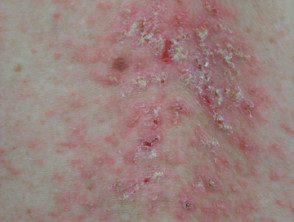
Darier disease in the middle of the back

Scalp disease

Facial cysts
Verruciform acrokeratosis
Warty papules on the back of the hands are known as verruciform acrokeratosis. Other signs may include:
- Small holes in the palms and soles.
- Bleeding under the skin
A located The variant of Darier's disease, in which the papules on the hands and feet are the main feature, is called Hopf's acrokeratosis verruciforme.
Most patients with Darier's disease will have broad white and reddish longitudinal stripes on some or all of their nails. A V-shaped notch on the free edge of the nail also suggests Darier's disease.
Darier hand and foot disease
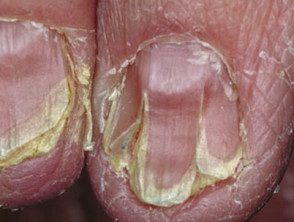
Nail disease
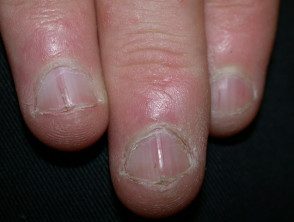
Nail disease
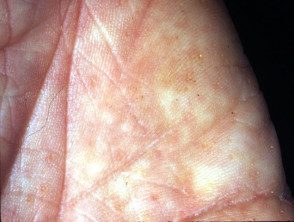
Holes Palmar
Injuries affecting the mucous membranes
Mucous membranes are the red, wet linings of body surfaces (mouth, esophagus, rectum, vulva, vagina) Patients with Darier's disease may have a white cobblestone pattern of small papules that affect the mucous membranes. Overgum growth can also occur.
Forecast and complications of Darier's disease
Most affected patients develop signs of Darier's disease before age 30.
- Many have mild and unnoticed Darier's disease.
- The most serious disease may have a chronic, relapsing-remitting pattern.
- The signs may disappear entirely.
Outbreaks can be caused by any of the following factors.
- Exposure to sunlight or heat.
- Current corticosteroids
- Bacterial infection
-
Herpes simplex infection - including severe varicelliform Kaposi eruption (see eczema herpetic).
In most patients, general health remains good, regardless of the severity of the disease.
Kaposi's varicelliform rash in Darier's disease
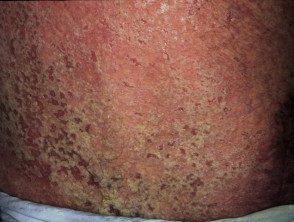
Darier's disease
What is the treatment of Darier's disease?
Treatment of Darier's disease is only required if there are troublesome symptoms. Mild illness can be managed with:
- Moisturizers
-
Solar protection
- Careful selection of clothing to avoid heat and sweating.
Localized Darier's disease can be treated by:
- Current retinoids
-
Dermabrasion
Secondary bacterial infection (usually due to Staphylococcus aureus) should be treated with antibiotics. Herpes simplex is treated with acyclovir or valacyclovir.
Severe Darier's disease is generally treated with oral retinoids, either acitretin or isotretinoin. Cyclosporine has been reported to be effective in some patients.
Darier's disease before and after acitretin treatment
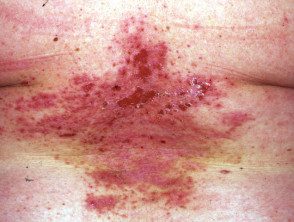
Dariers disease
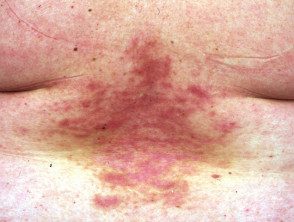
Dariers disease

